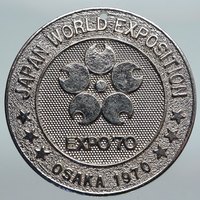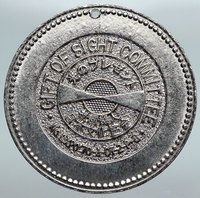Japan - 1970 World Exposition World's Fair
Gift of Sight Committee
1970 Steel Medal 37mm (18.63 grams)
*** JAPAN WORLD EXPOSITION *** EXPO '70 OSAKA 1970, Five stylized
circles around circle.
GIFT OF SIGHT COMMITTEE No EXPO'70 1-OT-2-P-8. Stylized eyeball. You are bidding on the exact item pictured, provided with a Certificate of Authenticity and Lifetime Guarantee of Authenticity.
 Expo '70 (日本万国博覧会, Nihon Bankoku Hakuran-kai) was a world's fair held in Suita, Osaka Prefecture, Japan between March 15 and September 13, 1970. Its theme was "Progress and Harmony for Mankind." In Japanese, Expo '70 is often referred to as Osaka Banpaku (大阪万博, Ōsaka Banpaku). It was the first world's fair held in Japan. Expo '70 (日本万国博覧会, Nihon Bankoku Hakuran-kai) was a world's fair held in Suita, Osaka Prefecture, Japan between March 15 and September 13, 1970. Its theme was "Progress and Harmony for Mankind." In Japanese, Expo '70 is often referred to as Osaka Banpaku (大阪万博, Ōsaka Banpaku). It was the first world's fair held in Japan.
The Expo was designed by Japanese architect Kenzo Tange, assisted by 12 other Japanese architects. Bridging the site along a north-south axis was the Symbol Zone. Planned on three levels, it was primarily a social space with a unifying space frame roof.
 Osaka was chosen as the site for the 1970 World Exposition by the Bureau International des Expositions (BIE) in 1965. 330 hectares in the Senri Hills outside Osaka had been earmarked for the site and a Theme Committee under the chairmanship of Seiji Kaya was formed. Kenzo Tange and Uzo Nishiyama were appointed to produce the master plan for the Expo. The main theme would be Progress and Harmony for Mankind. Tange invited 12 other architects to elucidate designs for elements within the master plan. These architects included: Arata Isozaki for the Festival Plaza mechanical, electrical and electronic installations; and Kiyonori Kikutake for the Landmark Tower. Osaka was chosen as the site for the 1970 World Exposition by the Bureau International des Expositions (BIE) in 1965. 330 hectares in the Senri Hills outside Osaka had been earmarked for the site and a Theme Committee under the chairmanship of Seiji Kaya was formed. Kenzo Tange and Uzo Nishiyama were appointed to produce the master plan for the Expo. The main theme would be Progress and Harmony for Mankind. Tange invited 12 other architects to elucidate designs for elements within the master plan. These architects included: Arata Isozaki for the Festival Plaza mechanical, electrical and electronic installations; and Kiyonori Kikutake for the Landmark Tower.
Two main principles informed the master plan. The first was the idea that the wisdom of all the peoples of the world would come together in this place and stimulate ideas; the second was that it would be less of an exposition and more of a festival. The designers thought that unlike previous expositions they wished to produce a central, unifying, Festival Plaza where people could meet and socialise. They called this the Symbol Zone and covered it and the themed pavilions with a giant space frame roof.
The designers liked the idea that like the 1851 Great Exhibition in London, the roof of the Symbol Zone could be a unifying entity for the expo. They did not want the constraint imposed by the London Exhibition of having everything contained under one roof, so the space frame contained only the Festival Plaza and themed pavilions. Tange compared the concept to a tree. The idea was that although the national pavilions were like individual flowers they needed to be connected to the whole via branches and a trunk. Thus the Symbol Zone became the trunk and the moving pedestrian walkways and sub-plazas became the branches. These elements were reinforced with colour, with the trunk and branches in plain white and the pavilions in their own colours that were determined by the national architects.
The Symbol Zone ran north–south across the site, spanning an arterial road running east–west. The Festival Plaza was to the north of road and had the main gate on its southern end. To the north of the main gate and central to the Festival Plaza was the Tower of the Sun from which visitors could join pedestrian walkways that travelled out towards the north, south, east and west gates.
The Theme Space under the space frame was divided into three levels, each designed by the artist Tarō Okamoto, The underground level represented the past and was a symbol of the source of humanity. The surface level represented the present, symbolising the dynamism of human interaction. The space frame represented the future and a world where humanity and technology would be joined. Tange envisioned that the exhibition for the future would be like an aerial city and he asked Fumihiko Maki, Noboru Kawazoe, Koji Kamiya and Noriaki Kurokawa to design it. The Theme Space was also punctuated by three towers: the Tower of the Sun, the Tower of Maternity and the Tower of Youth.
To the north of the Theme Space was the Festival Plaza. This was a flexible space that contained a flat area and stepped terrace. The plaza could be rearranged to provide for different requirements for seating capacity, from 1500 to 10000. The flexibility extended to the lighting and audio visual equipment allowing for a range of musical performances and electronic presentations. Festival Plaza was covered by the world's first large-scale, transparent membrane roof. It was designed by Tange and structural engineer Yoshikatsu Tsuboi + Kawaguchi & Engineers. Measuring 75.6 m in width and 108 m in length, it was 30 m high and supported by only six lattice columns.
Seventy-seven countries participated in the event, and within six months the number of visitors reached 64,218,770, making Expo '70 one of the largest and best attended expositions in history. It held the record for most visitors at an Expo until it was surpassed by the Shanghai World Expo in 2010.
.svg/220px-Japan_(orthographic_projection).svg.png)  Japan is an island nation in East Asia. Located in the Pacific Ocean, it lies to the east of the Sea of Japan, China, North Korea, South Korea and Russia, stretching from the Sea of Okhotsk in the north to the East China Sea and Taiwan in the south. The characters that make up Japan's name mean "sun-origin", which is why Japan is often referred to as the "Land of the Rising Sun". Japan is an island nation in East Asia. Located in the Pacific Ocean, it lies to the east of the Sea of Japan, China, North Korea, South Korea and Russia, stretching from the Sea of Okhotsk in the north to the East China Sea and Taiwan in the south. The characters that make up Japan's name mean "sun-origin", which is why Japan is often referred to as the "Land of the Rising Sun".
Japan is a stratovolcanic archipelago of 6,852 islands. The four largest islands are Honshu, Hokkaido, Kyushu, and Shikoku, which together comprise about ninety-seven percent of Japan's land area. Japan has the world's tenth-largest population, with over 126 million people. Honshū's Greater Tokyo Area, which includes the de facto capital of Tokyo and several surrounding prefectures, is the largest metropolitan area in the world, with over 30 million residents. Archaeological research indicates that people lived in Japan as early as the Upper Paleolithic period. The first written mention of Japan is in Chinese history texts from the 1st century AD. Influence from other regions, mainly China, followed by periods of isolation, particularly from Western European influence, has characterized Japan's history. From the 12th century until 1868, Japan was ruled by successive feudal military shoguns in the name of the Emperor. Japan entered into a long period of isolation in the early 17th century, which was only ended in 1853 when a United States fleet pressured Japan to open to the West. Nearly two decades of internal conflict and insurrection followed before the Meiji Emperor was restored as head of state in 1868 and the Empire of Japan was proclaimed, with the Emperor as a divine symbol of the nation. In the late 19th and early 20th centuries, victories in the First Sino-Japanese War, the Russo-Japanese War and World War I allowed Japan to expand its empire during a period of increasing militarism. The Second Sino-Japanese War of 1937 expanded into part of World War II in 1941, which came to an end in 1945 following the atomic bombings of Hiroshima and Nagasaki. Since adopting its revised constitution in 1947, Japan has maintained a unitary constitutional monarchy with an emperor and an elected legislature called the Diet. A major economic power, Japan is a developed country and has the world's third-largest economy by nominal GDP and the world's fourth-largest economy by purchasing power parity. It is also the world's fourth-largest exporter and fourth-largest importer. Although Japan has officially renounced its right to declare war, it maintains a modern military with the world's eighth largest military budget, used for self-defense and peacekeeping roles. Japan ranks high in metrics of prosperity such as the Human Development Index, with the Japanese population enjoying the highest life expectancy of any country in the world and the infant mortality rate being the third lowest globally.
| 

 Expo '70 (日本万国博覧会, Nihon Bankoku Hakuran-kai) was a world's fair held in Suita, Osaka Prefecture, Japan between March 15 and September 13, 1970. Its theme was "Progress and Harmony for Mankind." In Japanese, Expo '70 is often referred to as Osaka Banpaku (大阪万博, Ōsaka Banpaku). It was the first world's fair held in Japan.
Expo '70 (日本万国博覧会, Nihon Bankoku Hakuran-kai) was a world's fair held in Suita, Osaka Prefecture, Japan between March 15 and September 13, 1970. Its theme was "Progress and Harmony for Mankind." In Japanese, Expo '70 is often referred to as Osaka Banpaku (大阪万博, Ōsaka Banpaku). It was the first world's fair held in Japan. Osaka was chosen as the site for the 1970 World Exposition by the Bureau International des Expositions (BIE) in 1965. 330 hectares in the Senri Hills outside Osaka had been earmarked for the site and a Theme Committee under the chairmanship of Seiji Kaya was formed. Kenzo Tange and Uzo Nishiyama were appointed to produce the master plan for the Expo. The main theme would be Progress and Harmony for Mankind. Tange invited 12 other architects to elucidate designs for elements within the master plan. These architects included: Arata Isozaki for the Festival Plaza mechanical, electrical and electronic installations; and Kiyonori Kikutake for the Landmark Tower.
Osaka was chosen as the site for the 1970 World Exposition by the Bureau International des Expositions (BIE) in 1965. 330 hectares in the Senri Hills outside Osaka had been earmarked for the site and a Theme Committee under the chairmanship of Seiji Kaya was formed. Kenzo Tange and Uzo Nishiyama were appointed to produce the master plan for the Expo. The main theme would be Progress and Harmony for Mankind. Tange invited 12 other architects to elucidate designs for elements within the master plan. These architects included: Arata Isozaki for the Festival Plaza mechanical, electrical and electronic installations; and Kiyonori Kikutake for the Landmark Tower..svg/220px-Japan_(orthographic_projection).svg.png)
 Japan is an island nation in East Asia. Located in the Pacific Ocean, it lies to the east of the Sea of Japan, China, North Korea, South Korea and Russia, stretching from the Sea of Okhotsk in the north to the East China Sea and Taiwan in the south. The characters that make up Japan's name mean "sun-origin", which is why Japan is often referred to as the "Land of the Rising Sun".
Japan is an island nation in East Asia. Located in the Pacific Ocean, it lies to the east of the Sea of Japan, China, North Korea, South Korea and Russia, stretching from the Sea of Okhotsk in the north to the East China Sea and Taiwan in the south. The characters that make up Japan's name mean "sun-origin", which is why Japan is often referred to as the "Land of the Rising Sun".
